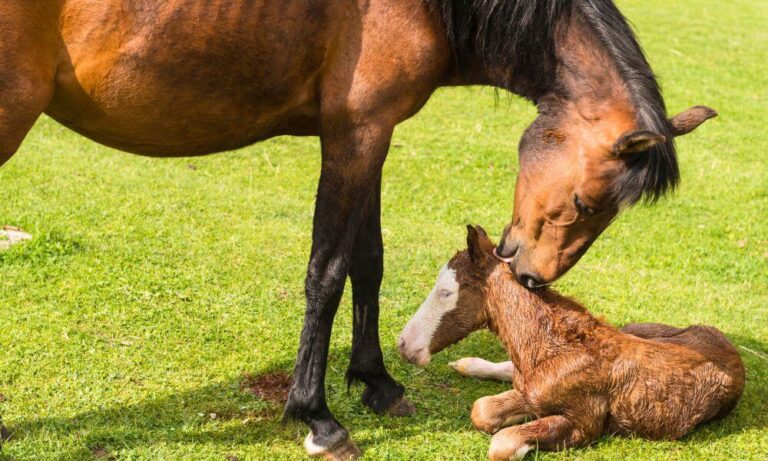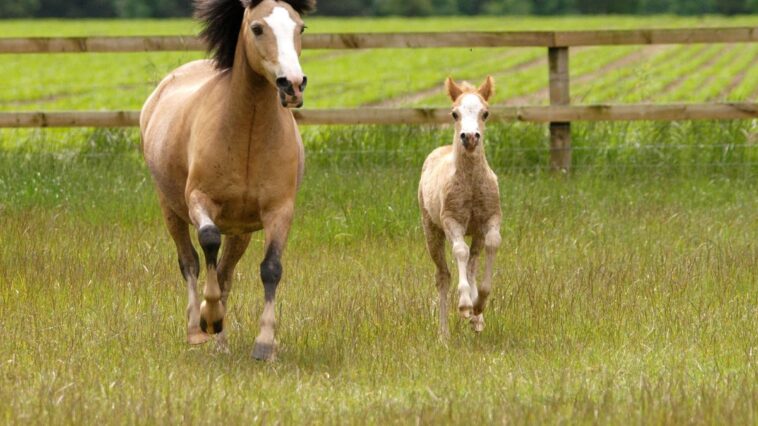Have you ever wondered what a baby horse is called? Well, look no further! From their adorable antics to their rapid growth, baby horses, known as foals, capture our hearts with their irresistible charm. In this article, we will explore the delightful world of these young equines and unveil the name given to a baby horse.
So, let’s dive into the captivating journey of what a baby horse is called – the adorable world of foals! Prepare to embark on an adventure exploring these enchanting creatures’ life and characteristics. Join us as we delve into the fascinating realm of foals and discover the unique qualities that make them endearing.
What is a Baby Horse Called?
A baby horse is called a “foal.” The term “foal” describes a young horse from birth until it reaches the age of about one year. During this period, foals undergo significant growth and development as they transition from newborns to juvenile horses.
When a foal is born, it is generally small, with long legs that appear disproportionate to its body. Its coat may be soft, fuzzy, and often playful and curious. Foals rely on their mothers for nourishment, as they consume their mother’s milk for the first few months.
Foals typically spend their early days close to their mothers, learning from them and developing social bonds within the herd. They engage in exploratory behavior, testing their coordination and learning about their surroundings. As time progresses, foals transition to grass and another vegetation diet, gradually weaning off their mother’s milk.
During this stage, foals need proper care, nutrition, and veterinary attention to ensure healthy growth and development. They need a safe and supportive environment to roam, play, and learn essential skills. Regular veterinary check-ups help monitor their health and address any potential issues promptly.
As foals grow and mature, they gradually transform into young horses, losing their foal-like characteristics. The transition from foal to horse generally occurs around the age of one, at which point they are considered yearlings. From there, they progress through adolescence and eventually reach adulthood.
In summary, a baby horse is called a “foal.” Foals represent the early stages of a horse’s life, filled with curiosity, playfulness, and rapid growth. They rely on their mothers for nourishment and guidance, gradually developing into independent and majestic adult horses.
Different Names for Baby Horses

Baby horses are given different names based on their gender and age. Let’s explore the various terms used to refer to these young equines in detail:
Foal: The term “foal” describes a baby horse of either gender from birth until the age of about one year. During this period, foals undergo significant growth and development.
Colt: A male baby horse is called a “colt.” Colts retain this designation until they reach the age of four. They are characterized by their youthful energy, playfulness, and inquisitive nature. As colts mature, they undergo physical changes and develop the distinguishing features of adult male horses, such as a muscular build and prominent facial structure.
Filly: A female baby horse is called a “filly.” Like colts, fillies retain this name until they reach the age of four. As fillies grow, their bodies develop, and they acquire the physical attributes associated with adult female horses. Fillies often display gracefulness and elegance, exhibiting their potential as future broodmares or competitive horses.
Yearling: Once a foal reaches the age of one year, it is commonly called a “yearling.” Yearlings are no longer considered foals but are still in their early development stages. During this stage, yearlings experience further growth and continue to refine their coordination and social skills.
Gelding: A gelding is a male horse that has been castrated. Castration is often performed to modify behavior or eliminate the possibility of reproduction. It is important to note that “gelding” refers to the horse’s altered state rather than age. Geldings can range in age from foals to adult horses.
Weanling: A weanling is a young horse that recently separated from its mother and no longer depends on her milk for nourishment. Weanlings are typically around six to eight months old. This transition period can be a significant adjustment for the young horse as it learns to eat solid food and adapt to a more independent lifestyle.
As horses mature beyond these stages, they are generally referred to as “horses” or are given specific terms based on their sex and reproductive status, such as “stallion” (mature intact male), “mare” (mature female), or “gelding” (castrated male).
Baby horses are given different names based on gender and age. A male baby horse is called a “colt,” a female baby horse is called a “filly,” and both are referred to as “foals” until they reach the age of four. At one year of age, they are known as “yearlings.” It’s important to note that “gelding” refers to a castrated male horse, and a “weanling” is a young horse recently separated from its mother.
The Development Stages of a Baby Horse
The development stages of a baby horse, from birth to maturity, encompass several significant milestones. Let’s explore these stages in detail:
Birth: The journey of a baby horse begins with its birth, often referred to as foaling. Foals are usually born lying down and can stand and walk within a short period, typically within one hour after birth. They are born with their eyes open and begin to nurse from their mother soon after standing.
The neonatal Stage covers the first few weeks of a foal’s life. During this period, the foal depends entirely on its mother’s milk for nutrition. It rapidly grows and gains strength, developing coordination and stability while interacting with its mother and other herd members.
Weaning: Weaning marks the separation of the foal from its mother and the transition from a milk-based diet to solid food. This process usually occurs around four to six months of age, although the timing can vary. Weanlings eat grass, hay, and other forage, gradually reducing their reliance on their mother’s milk.
Juvenile Stage: The juvenile stage encompasses the period from weaning to approximately two to three years. During this time, the young horse experiences rapid growth and development. Its primary focus is acquiring social skills, learning herd dynamics, and developing physical strength and coordination. Proper nutrition, veterinary care, and regular exercise are essential for its healthy growth.
Adolescence: As the horse reaches two to three years of age, it enters adolescence. This phase is marked by continued growth and physical development, including the maturation of skeletal structure and the onset of sexual maturity. Young horses may display increased energy, assertiveness, and independence during this period.
Maturity: Horses generally reach physical and sexual maturity between the ages of four and six, although individual horses may vary. The horse has fully developed its skeletal structure and muscle mass at this stage. Mares are typically capable of reproduction, and stallions exhibit adult male horses’ behavioral and physical characteristics.
Adult Stage: Beyond the maturity stage, horses are considered adults. They have fully developed physically and mentally, reaching their maximum size and strength. Adult horses can perform various tasks like riding, driving, and competing in equestrian sports.
Throughout their development, horses require proper nutrition, veterinary care, regular exercise, and social interaction to ensure their well-being and proper growth. Each stage shapes the horse’s behavior, physical attributes, and overall potential as a companion or working animal.
It’s important to note that each stage’s duration and characteristics can vary depending on factors such as breed, genetics, individual development rate, and environmental factors.
Amazing Facts About Baby Horses
Here are some fun facts about baby horses:
Quick Learners: Foals are incredibly fast learners. They can stand, walk, and even trot within hours after birth. They quickly develop coordination and agility, allowing them to explore their surroundings and interact with their environment.
Playful Nature: Foals have a naturally playful and curious nature. They engage in various playful behaviors, such as chasing each other, jumping, and bucking. These playful activities help them develop their physical abilities, balance, and social skills.
Sleeping Position: Foals have a unique sleeping position known as “sternal recumbency.” Unlike adult horses that sleep standing up, foals often lie on their sides or chests. This allows them to rest and conserve energy more comfortably.
Rapid Growth: Foals experience rapid growth during their first year of life. They can gain up to 2-3 pounds (0.9-1.4 kg) in weight each day. This growth rate gradually slows down as they approach maturity.
Milk Teeth: Like humans, foals have baby or milk teeth that are gradually replaced by permanent adult teeth as they grow. By the age of two-and-a-half to three, most of their permanent teeth have erupted.
Social Bonds: Foals develop strong social bonds with their mothers and other herd members. They learn important social skills and behaviors by interacting with other foals and adult horses. These early social experiences shape the herd’s future behavior and social dynamics.
Coat Color Changes: The coat color of a foal can change as it matures. Some foals are born with a coat color that differs from their eventual adult coloration. This is particularly common in horses with gray or roan coat patterns.
Milk Production: A mare’s milk production is tailored to meet the specific nutritional needs of her foal. The composition of a mare’s milk changes as the foal grows, providing essential nutrients and antibodies for its healthy development.
Independence: Foals gradually gain independence from their mothers as they grow older. Around six months of age, they become more self-sufficient, transitioning to solid food and developing social interactions within the herd.
Weaning Behavior: When it’s time for a foal to be weaned, both the foal and its mother may display behaviors of resistance or protest. This separation can be a challenging time for both the foal and the mare as they adjust to the changes in their relationship.
These fun facts highlight baby horses’ remarkable characteristics and development, showcasing their resilience, adaptability, and the joy they bring to the equine world.
Caring For a Newborn Foal

Caring for a newborn foal requires special attention and care to ensure its health and well-being. Here are some essential aspects to consider:
Bonding and Observation:
- Allow the foal to bond with its mother naturally.
- Observe their interactions closely to ensure a strong bond is forming.
- Monitor the foal’s behavior, nursing, and overall health during this critical period.
Colostrum Intake: Ensure the foal receives colostrum, the mare’s first milk rich in antibodies. This provides essential immunity and protects the foal from infections. Ideally, the foal should nurse within the first few hours of birth.
Veterinary Check-Up: Schedule a veterinarian examination for the foal within 24 to 48 hours after birth. The vet will assess the foal’s overall health, check for abnormalities, and guide care and feeding.
Adequate Nutrition: Foals primarily rely on their mother’s milk for nutrition. Ensure the mare has a proper diet and access to fresh water to support milk production. Regularly monitor the foal’s weight gain to ensure it is receiving sufficient nourishment.
Foal Milk Replacer: In certain situations where the mare cannot produce enough milk or if the foal is orphaned, a foal milk replacer may be necessary. Consult a veterinarian for guidance on selecting an appropriate milk replacer and establishing a feeding schedule.
Safe Environment:
- Create a safe and comfortable environment for the foal.
- Ensure the foaling area is clean, free of hazards, and offers adequate space for the mare and foal to move around.
- Remove any potential sources of injury, such as sharp objects or loose wires.
Regular Monitoring:
- Observe the foal’s behavior, nursing frequency, and urination/defecation patterns.
- Monitor for signs of illness, such as lethargy, loss of appetite, abnormal stool, or abnormal behavior.
- Contact a veterinarian promptly if you notice any concerning symptoms.
Hoof Care: While foals’ hooves are usually self-trimming in the early weeks, monitoring their growth and ensuring proper hoof development is important. Consult with a farrier or veterinarian for guidance on trimming if necessary.
Socialization: Allow the foal to socialize with other horses gradually. Introduce them to gentle and well-behaved adult horses to promote healthy social interactions and learning.
Gradual Weaning: Foals are typically weaned from their mothers between four to six months of age. This transition should be done gradually to minimize stress. Consult with a veterinarian for guidance on the appropriate timing and weaning process.
Remember, each foal is unique, and adapting the care based on individual needs and circumstances is essential. Regular veterinary check-ups,
proper nutrition and a safe environment are key elements in ensuring the health and well-being of a newborn foal.
Conclusion
A baby horse is called a “foal.” Foals are adorable and energetic creatures that undergo significant growth and development during their first year. They quickly learn to stand, walk, and play, showcasing their instincts and athleticism. Caring for a newborn foal involves:
- Ensuring proper bonding with its mother.
- Monitoring its health.
- Providing adequate nutrition.
- Creating a safe environment.
You can help a foal thrive and set the foundation for a healthy and happy adult horse by offering attentive care and nurturing.
The Irish Wolfhound is a giant breed of dog that originated in Ireland. They have a rough, wiry coat that can be various shades of gray, brindle, or fawn. These dogs can weigh up to 180 pounds and stand up to 34 inches at the shoulder.
This breed was originally bred as a hunting dog and is known for its courage, loyalty, and intelligence. Irish Wolfhounds have a life span of around 6-8 years, shorter than most other dog breeds. Despite their short life span, they are beloved for their gentle and affectionate nature.




